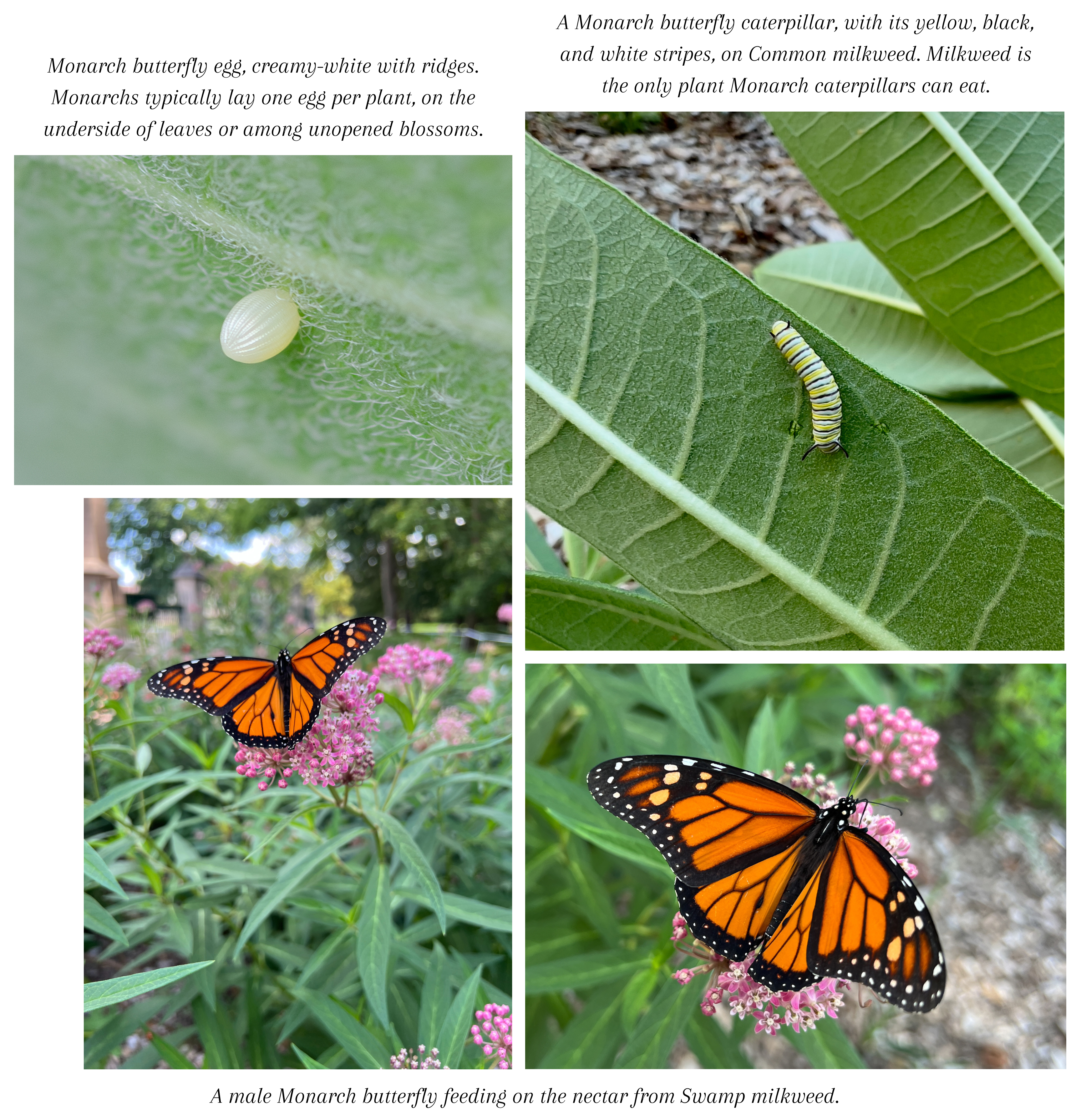Monarch Butterflies Visit Our Pollinator Garden!
 Woohoo! We have butterflies! This spring, the Crown Hill Foundation planted a fantastic pollinator garden located just inside the 34th Street Gothic gate entrance, and it’s been very successful! As seen in these photos, we’ve had Monarch butterflies laying eggs all summer on our four varieties of milkweed plants, which is the only type of plant a Monarch caterpillar will eat! (Without milkweed, we would not have Monarchs!).
Woohoo! We have butterflies! This spring, the Crown Hill Foundation planted a fantastic pollinator garden located just inside the 34th Street Gothic gate entrance, and it’s been very successful! As seen in these photos, we’ve had Monarch butterflies laying eggs all summer on our four varieties of milkweed plants, which is the only type of plant a Monarch caterpillar will eat! (Without milkweed, we would not have Monarchs!).
Our talented Arborist, Carrie Tauscher, designed this amazing garden in the shape of a butterfly wing, in celebration of all pollinators. Carrie facilitated its creation and has worked with staff and community members to plant and care for it. In addition to a wide variety of pollinator plants (plants that produce nectar and pollen and attract insects known as pollinators), the four native varieties of Milkweed represented in our garden include Swamp milkweed (Asclepias incarnata), Common milkweed (Asclepias syriaca), Whorled milkweed (Asclepias verticillate), and Butterfly Weed (Asclepias tuberosa).
 The lifecycle of a Monarch butterfly will take about one month to complete, from its egg, caterpillar (larva), chrysalis (pupa), to the butterfly. Their tiny, creamy-white eggs, merely the size of a pin head, will hatch a baby caterpillar that feeds exclusively on the leaves of its host milkweed plant, shed its skin five times before forming a chrysalis, then emerge 9-11 days later as a butterfly! At our latitude, Monarchs “born” after August 15 are members of the long-living migratory generation. Millions of these beautiful butterflies will migrate 2,000-3,000 miles south to spend the winter in the oyamel fir forests that comprise the Monarch biosphere sanctuaries high in the mountains of Central Mexico!
The lifecycle of a Monarch butterfly will take about one month to complete, from its egg, caterpillar (larva), chrysalis (pupa), to the butterfly. Their tiny, creamy-white eggs, merely the size of a pin head, will hatch a baby caterpillar that feeds exclusively on the leaves of its host milkweed plant, shed its skin five times before forming a chrysalis, then emerge 9-11 days later as a butterfly! At our latitude, Monarchs “born” after August 15 are members of the long-living migratory generation. Millions of these beautiful butterflies will migrate 2,000-3,000 miles south to spend the winter in the oyamel fir forests that comprise the Monarch biosphere sanctuaries high in the mountains of Central Mexico!
We encourage you to visit our garden and observe the wide variety of pollinators who visit and feed from it, including the Monarchs, other butterflies, bees, etc. Enter our 34th Street gate at 3400 Boulevard Place, and you can park next to the garden on the south side, across the street from the Waiting Station.
We are extremely appreciative of the community support given to make this garden happen! Warm thanks go to:
- Shortridge High School Environmental Club for preparing the site for planting.
- K-4th Grade Student Ambassadors from the Paramount Cottage Home Charter School for planting hundreds of 23 Indiana native species of pollinator plants.
- The Brooks and Joan Fortune Family Foundation for their generous financial support for the establishment of the pollinator garden, the development of the nature trail through the south woods next to the garden, and the soon-to-be-placed age and ADA-friendly picnic tables with adaptive seating that can also serve as learning stations for students on field trips. These tables are being constructed locally using local hardwoods.
- The National Bank of Indianapolis for their generous financial support for the establishment of the pollinator garden.
- Our staff and the many volunteers who weed and care for the garden.
Click to watch a Monarch mom, laying a single egg on the unopened blossoms of Swamp milkweed. A Monarch can lay over 500 eggs.

